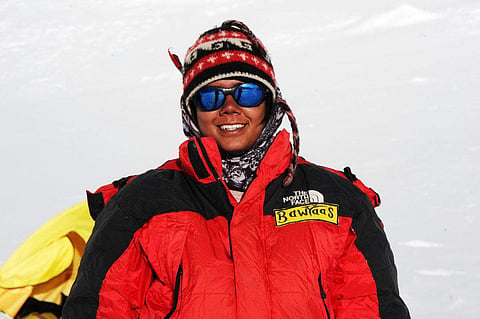

“Is this the last photograph? Yes? So, I can remove these stilettos after this? Phew!” 27-year-old Krushnaa Patil breathes a sigh of relief. The mountaineer, who was the youngest woman to conquer the heights of Mount Everest in 2009 at the age of 19, clearly does not like wearing heels. And why would she when her trekking shoes give her more comfort, while also allowing her to explore more places on Earth.
Krushnaa was addressing a crowd of enthusiastic women who were all set to return to work after a career break, at the second edition of Paypal’s Recharge 2.0. We catch up with her for a quick chat after her talk. Excerpts:
How differently do youngsters perceive mountaineering?
Mountaineering is not easy. This young generation of mountaineers are very responsible and know what is happening. They’re set to bring about change. In the 80s and 90s, weather reports and equipment weren’t great and hence, if something went wrong, people would leave everything and run for their life. That is why stuff got left behind. Those are the things you’d see on the mountain; it’s not really garbage. Old mountaineers didn’t leave food wrappers because they wanted to; some of them thought it wouldn’t make a difference but others had to run without packing their stuff.
What can mountaineers do to tackle pollution on the mountains?
Honestly, we can do a lot. Garbage in the higher regions of the mountains is uncommon. But of course, there is a certain amount of garbage. All my expeditions so far have been zero impact or eco-expeditions. We use solar cookers, solar panels and we even carry our human waste back. You’re not allowed to ‘poop’ in most of the sanctuaries. We have scientifically designed poop bags which allows you to carry it back. In Antarctica, you aren’t even allowed to spit, as it leaves behind your DNA for years and there is no renewal of resources. During my first expedition in 2008, we brought back a ton of waste from the Gangotri. When I climbed Everest in 2009, we brought back eight tons of garbage.
How did you do that?
Our leader started the Cash for Trash campaign to clean up Everest, which was 100 Nepalese rupee for every kilo of old garbage that was brought down. As mountaineers, we do three trips back to base camp empty, after we keep our stuff on the top of the mountain. So we used that potential to bring back the garbage. Sherpas would carry about 60 kilos of garbage. I could carry about 10 kilos. Until now, the campaign has collected over 50 tons of garbage. So mountaineers can bring about a change, but they need money for it. There needs to be some sort of support.
What was the biggest problem that you faced when you decided to climb mountains?
Money. It still is. I had to change the entire sport to bring in some money. I do not want CSR funds. I want sponsors to fight over who gets to sponsor the next mountaineering event. Only then will the sport becomes sustainable and will more people be attracted to it. I’m sure we can tackle the problem very soon.
Of all the places you’ve visited, which one is your favourite?
Russia and Antarctica. Antarctica is a magical place and doesn’t even feel like a part of Earth. It could be the moon! (laughs).
